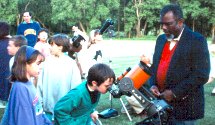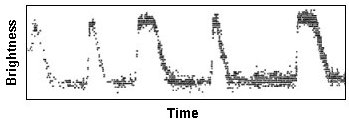![[AAVSO Logo]](gb_shield.gif)
American Association of Variable Star Observers (AAVSO)
|
The American Association of Variable Star Observers (AAVSO) is a non-profit
worldwide scientific and educational organization of amateur and
professional astronomers who are interested in stars that change in
brightness--variable stars.
The AAVSO was founded in 1911 at Harvard College Observatory to coordinate variable star observations made largely by amateur astronomers. In 1954, the AAVSO became an independent, private research organization. Today with members in 46 countries, and headquarters in Cambridge, Massachusetts, USA, it is the world's largest association of variable star observers. The AAVSO coordinates, evaluates, compiles, processes, publishes, and disseminates variable star observations to the astronomical community throughout the world. The archives of the AAVSO currently contain over 9 million observations. Approximately 575 observers from around the world send over 300,000 observations each year. At the end of each month, incoming observations are sorted by observer and checked for errors. They are converted into computer readable form and processed using computer systems at AAVSO Headquarters. These observations are then added to the data files for each star in the AAVSO International Database. This database is a tribute to the skill, enthusiastic devotion, and dedication of AAVSO observers since 1911.
Benefits of MembershipMembers receive all the information and material needed to establish their own variable star observing program, subscriptions to the Journal of the AAVSO and the AAVSO Newsletter , and may choose from a large number of other publications available free of charge to members. Also, members receive notices of the semi-annual meetings of the AAVSO which they are encouraged to attend, and other mailings.Services to the Observer
Upon request, the AAVSO will help set up an appropriate observing program for an individual, an astronomy club, an elementary school, high school, or college, etc. In this way observers, students, and faculty are able to make the best use of their resources and to do valuable science. The AAVSO can also assist in teaching observing techniques and in suggesting stars to be included in a program. Services to the Astronomical CommunityAAVSO data, both published and unpublished, are made available to astronomers around the world. AAVSO services are sought by astronomers for:
Services in Education
AAVSO Observing ProgramsVisual: Most AAVSO observations are made visually. Stars best suited for visual observation have amplitudes of variation of more than one magnitude. The limiting magnitude of observations is 16.5 and the accuracy of the data is between ±0.2 and ±0.4 magnitude. The AAVSO Visual Observing Program includes about 3600 variable stars.Photoelectric: Stars with small variations can be observed photoelectrically. The AAVSO Photoelectric Observing Program contains 50 bright, mostly red variables with less than 1 magnitude of variation. The photoelectric and the visual observing programs complement each other since most of these stars are also in the visual observing program. The accuracy of photoelectirc observations is ±0.008 magnitude. Charge-Coupled Device (CCD): The minima of faint variables can be observed even with a small telescope equipped with a CCD. The CCD observing program consists of mostly long period variables in the visual program. Faint CCD observations complement both of the other observing programs of the AAVSO. Divisions and CommitteesObservations of most types of variable stars are coordinated and published by the Director and the technical staff at AAVSO Headquarters. Observing for certain types of stars is coordinated outside AAVSO Headquarters, under the authority of the AAVSO Director. These committees and divisions are:
In addition, there is a New Charts Committee to oversee the preparation of new variable star charts and a Telescope Committee that is responsible for receiving and selling telescopes donated to the AAVSO. The Chairs of these committees operate volunatrily.
Membership in the AAVSO is open to anyone interested in variable stars and in contributing to the support of valuable research. Research on variable stars is important because it can provide much information--mass, radius, internal and external structure, composition, temperature and luminosity--about the properties of these stars. This information can then be extrapolated to other types of stars, including our Sun. Amateur astronomers are making a real and useful contribution to science by observing variable stars and submitting their observations to the AAVSO International Database. They have both time and ready access to observing instruments needed to gather data on the brightness changes of thousands of variable stars. In addition to contributing valuable observations, you can support the work carried on at Headquarters through your annual membership dues. To become a member, or to obtain more information, please contact: AAVSO Headquarters 25 Birch Street Cambridge, MA 02138 USA Phone: 617-354-0484 Fax: 617-354-0665 email: aavso@aavso.org Visit the AAVSO web site at http://www.aavso.org and visit the AAVSO Hands-On Astrophysics website at http://hoa.aavso.org |
||||||||||||||||||||||





